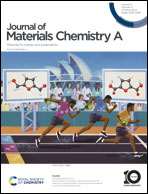Organic small molecular heterostructures for enhanced photocatalytic hydrogen evolution via isomer engineering†
Abstract
Conjugated organic molecular heterostructures have been widely investigated as a substitute catalyst for the photocatalytic hydrogen evolution reaction (HER). The controllable replacement of pure carbon rings with heterocyclic units can significantly change the ultraviolet-visible light harvesting and photogenerated carrier separation and transport. Thus, we introduce isomer engineering to develop efficient HER catalysts based on quinquephenyl-based molecules with the same elemental composition. Among these catalysts, the central phenyl-linked thiophene molecule P-TP, with graphitic carbon nitride, exhibits a remarkable hydrogen production rate and outstanding photocatalytic stability. Experiments and theoretical calculations reveal that the central phenyl-linked phenyl molecule P-PT is catalytically inactive, while the isomer P-TP, with a planar aromatic structure and delocalized π electrons, enables the heterostructure to have fast intermolecular charge transfer and strong binding energy, and so exhibit efficient photocatalytic activity. More importantly, the well-regulated molecular structure and catalytic activity in the organic small molecular isomeric photocatalysts highlight a new opportunity for photocatalytic HER.



 Please wait while we load your content...
Please wait while we load your content...